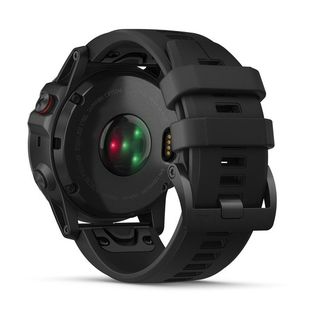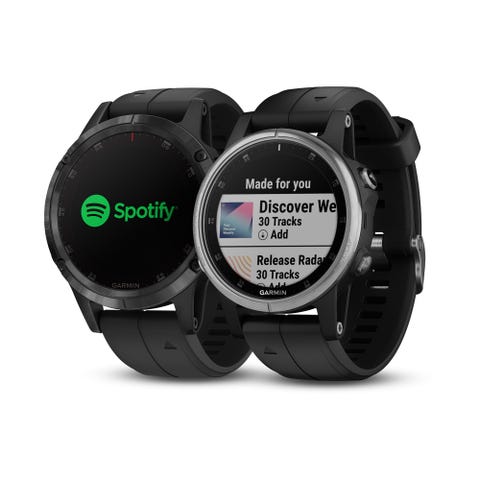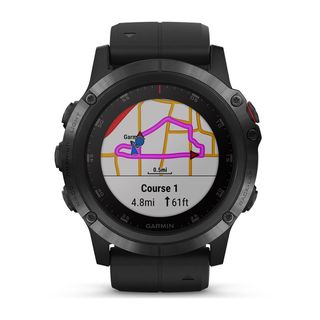Leave the phone at home, but still play music and get turn-by-turn directions on your run route.
Price: Starting at A$999
Weight: 5S Plus, 65g; 5 Plus, 85g; 5X Plus, 96g
Use: Multisport
Battery Life: 5S Plus, up to 11 hours; 5 Plus, 18 hours; 5X Plus, 32 hours
BUY NOW!
I’ve long loved especially the Garmin Fenix series of watches, dating back to the first model in 2012 that was targeted at hikers and outdoors enthusiasts. Over the years, Garmin has also built a great lineup of runner-specific watches, but I’ve stayed with the Fenix’s various updates because they’re built like a tank and have an insane battery life. I love that I need to charge the watch only about once a week – and I don’t have to fret if I forget the charger at home when I am travelling.
Over the four subsequent updates, Garmin has rolled out useful multisport and smartwatch features, making the Fenix the only timekeeper a runner really needs – albeit at a premium price.
The Fenix 5 Plus series, strangely, doesn’t get a new number – then again, Garmin skipped 4 and went directly from 3 to 5 in 2017, so the inconsistency is par for the course. But this line of Fenix watches looks, feels, and functions much like the previous generation, with a just few exciting updates – routes and music. The watch also performs all the usual actions we’ve come to expect from pricey GPS watches like pace, cadence, advanced workouts, and smartwatch connectivity, but I won’t go into detail about those features. Instead, let’s look at what sets this watch apart from the competition.
First, there are still three sizes available: I tested the midsized 5 Plus (47mm case), but it also is available in a smaller 5S Plus (42mm) and the gigantic 5X Plus (51mm). All three are big, heavy multisport watches with rugged construction and still boast extremely long-running batteries. Though their cases are different sizes, all feature the same size display and have a 3cm-diameter colour screen that’s easily visible even in direct sunlight.
Each of those models accurately tracks your workouts and daily activity, plus each has a barometric altimeter for accurate gain/loss readings. If you’re the type to leave everything at home, you’ll like that each watch supports Garmin Pay, so you can hit the coffee shop at the end of your run without toting along cash or a credit card. And all support Strava segment notification so you know when to hammer a certain stretch of road.

The Differences
Much like the previous generation, the 5X stands out with extra features beyond what the two smaller watches have. Last year, that addition was routable courses that you could create on the fly. This year, all three watches sport that feature, while the 5X Plus is the only model that gets a “Pulse Ox” sensor. By adding a red LED light to the backside of the watch case, Garmin is measuring the amount of oxygen saturation in your blood. Why would you care? Say you’re training at altitude, you’d be able to tell how well you’re acclimating to the change in elevation. But because it’s largely a feature that only the most extreme or competitive types will want or need, it’s limited to the most premium version of the watch for now.
The other big difference, which will likely be the biggest determining factor aside from physical size, is the battery life. Each model has different run times. The 5X, being the biggest, goes longest between charging – up to 32 hours with GPS running or 13 hours with GPS tracking and music streaming via Bluetooth. The midsized 5 Plus dips to 18 and 8 hours, respectively, which is still generous for a sports watch. The 5S Plus will leave a good many marathoners in silence; it’ll cut out after 4.5 hours with GPS and music going, but can track a run for up to 11 hours without music playing.
Music Onboard
As mentioned above, music is the biggest selling point for these new watches – especially now that the Fenix 5 Plus line supports Spotify (you need a premium membership to listen offline).
Thanks to Bluetooth headphones and music players built in to watches, I’ve become a convert to music on runs – I ran in silence for more than three decades. My typical, everyday training watch has become the Apple Watch (now Series 4), thanks to the ease at which you can choose songs and stream music. But the Fenix is a close second, mostly because it takes a little more effort to get the tunes you want.
With the Apple Watch and a cellular connection, you can say “Hey, Siri, play some pop music,” and the watch will surprise you with some upbeat tunes you may not have heard before. Or, maybe you’re just really in the mood to hear Jimmy Buffett? Just ask Siri (even if you’ve left your phone at home). Your catalogue is limitless, and you don’t have to fiddle with menus or buttons to change songs.
The Fenix, on the other hand, can play only what you’ve previously transferred to the watch. To do so, you need to navigate deep into settings on the watch itself, then choose from your playlists or recently played. Of course, you’re working on a 3cm screen and a device with limited power, so it’s a slow process and the song titles are truncated (tip: idle on a title for a couple seconds until the text starts scrolling across the screen). When you select a playlist, the watch will connect to WiFi and begin transferring files.
Sure, it’s a little cumbersome, and much slower than moving music to an Apple Watch, but, if you’re used to running with an iPod full of tracks, you’re already accustomed to being limited to your favourite tunes that you have at hand.
A quirk: You can transfer playlists only, not individual songs or albums. And, when playing the music on the watch, you can’t dig into the playlist to get at a particular song – you’re limited to skip, back, and shuffle controls.
Not a paying subscriber to Spotify, iHeartRadio, or Deezer? That’s okay, you can still drag and drop your own mp3 files to listen to on your run.
Round-Trip Courses
If we’re being honest, most of us stick to the same couple routes near home or work, right? So, a course-creation feature may not sound all that exciting, but I’ve found it’s pretty neat if you’re travelling and don’t want to carry a napkin with directions jotted on it. This feature, previously, was limited to the 5X, but gets rolled out to all three models this year.
To create a route, you go to Navigation > Round-Trip Course on the watch, and then specify a distance from 1 to 160km and which direction you’d like to head (it defaults to “any”). The watch will do some calculations and in under a minute spit out a loop route you can follow, complete with prompts when you need to turn. If you don’t like that option, it will create two more using the same inputs.
Truthfully, it’s really quite cool to be able to do this on the watch, without ever having to pinch and zoom on a Google map to see the roads around you. But, it comes with a caveat: The routes are never where I’d typically run, personally. For example, near my home in Jersey City, New Jersey, US, I like to run along the Hudson River Waterfront Walkway – it’s a largely uninterrupted bike path on the river’s edge that lets me get in car-free miles. The routes the Fenix creates, on the other hand, typically loop me up through city streets, with lots of intersections and alongside some fairly busy roads. It’s not dangerous, by any means, but the roads are more heavily trafficked than I’m looking for. The reason is because Garmin is leveraging the popularity of roads from activities uploaded to its database, so in typical use you should get a route that will serve you well.
WiFi for the People
When you’re all done with your run and head for the shower, your data uploads to Garmin Connect automatically thanks to built-in WiFi support on all three models. Previously, WiFi was limited to the Sapphire versions – you also got a scratch-resistant glass for the $250 upcharge. Of course, if you’re not at home, you can still post your workout by opening the Garmin Connect app on your phone.
Testing Notes
As I said above, most of my runs are logged using the Apple Watch Series 4 simply because that watch includes cellular connectivity – I can stream any song I want, or even make and receive phone calls. And, on most runs where I already know the distance of my route or am going at a leisurely jog, its feature set is more than enough.
But, in any other situation, I’m reaching for the Garmin Fenix 5 Plus. The accuracy of the GPS tracking is better than I’ve found in previous generations of the watch. Plus I get all of the advanced workout functionality, like lap splits and interval workouts, that is helpful when doing serious training. Now that the watch supports Spotify, I may end up reaching for it more often.

